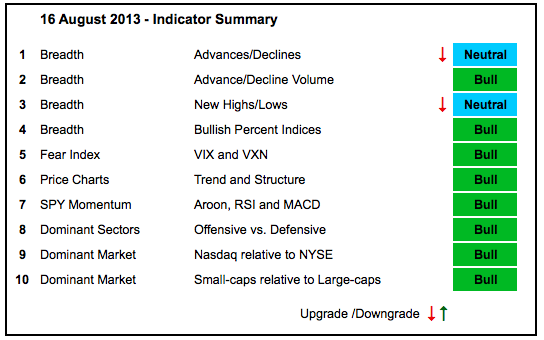Stocks were hit with broad selling pressure over the past week, but this is not enough to affect the overall uptrends. As we saw in November and June, corrections are normal in uptrends. The challenge, as always, is distinguishing between a normal correction and the start of something more (extended decline). For now, I will label this a correction. The main concern is with the Net New Highs indicators. NYSE Net New Highs plunged into negative territory and Nasdaq Net New Highs edged into negative territory. It is a bit early in the corrective process for such an expansion of new lows.


- AD Lines: Neutral. The Nasdaq AD Line hit a new high in early August and pulled back sharply the last two weeks. The overall trend, however, remains up since the mid November low. The NYSE AD Line did not exceed its May high and fell sharply the last three weeks. The overall trend is still up, but this indicator shows relative weakness.
- AD Volume Lines: Bullish. The Nasdaq AD Volume Line pulled back rather modestly the last two weeks and remains in an uptrend overall. The NYSE AD Volume Line fell the last three weeks, but remains in an uptrend overall.
- Net New Highs: Neutral. Nasdaq Net New Highs dipped into negative territory for the third time this year (April, June and August). The dip is normal for a correction as long as it holds above -2%. NYSE Net New Highs dipped below -2% for the first time since June, which marked the prior correction.
- Bullish Percent Indices: Bullish. All nine sector Bullish Percent Indices are still above 50%.
- VIX/VXN: Bullish. The S&P 500 Volatility Index ($VIX) and the Nasdaq 100 Volatility Index ($VXN) surged off their 2013 lows, but remain in downtrends overall.
- Trend-Structure: Bullish. DIA, IWM, MDY, QQEW and SPY recorded 52-week highs in August and remain in uptrends all.
- SPY Momentum: Bullish. RSI moved into the 40-50 zone, which may offer support. MACD (5,35,5) remains positive. The Aroon Oscillator moved into negative territory, but remains above -50.
- Offensive Sector Performance: Bullish. XLK, XLY, XLF and XLI recorded 52-week highs over the last few weeks. Even though they pulled back sharply this week, the overall trends remain up for the offensive sectors and they are leading the defensive sectors.
- Nasdaq Performance: Bullish. The $COMPQ:$NYA ratio broke out in early May and remains in an uptrend as the Nasdaq outperforms the NY Composite.
- Small-cap Performance: Bullish. The $RUT:$OEX ratio stalled the last few weeks, but remains in an uptrend since the early May breakout.
- Breadth Charts (here) and Inter-market charts (here) have been updated.
This commentary and charts-of-interest are designed to stimulate thinking. This analysis is
not a recommendation to buy, sell, hold or sell short any security (stock ETF or otherwise).
We all need to think for ourselves when it comes to trading our own accounts. First, it is
the only way to really learn. Second, we are the only ones responsible for our decisions.
Think of these charts as food for further analysis. Before making a trade, it is important
to have a plan. Plan the trade and trade the plan. Among other things, this includes setting
a trigger level, a target area and a stop-loss level. It is also important to plan for three
possible price movements: advance, decline or sideways. Have a plan for all three scenarios
BEFORE making the trade. Consider possible holding times. And finally, look at overall market
conditions and sector/industry performance.

About the author:
Arthur Hill, CMT, is the Chief Technical Strategist at TrendInvestorPro.com. Focusing predominantly on US equities and ETFs, his systematic approach of identifying trend, finding signals within the trend, and setting key price levels has made him an esteemed market technician. Arthur has written articles for numerous financial publications including Barrons and Stocks & Commodities Magazine. In addition to his Chartered Market Technician (CMT) designation, he holds an MBA from the Cass Business School at City University in London.
Learn More





